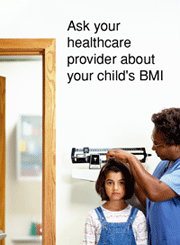We Can!® Community News Feature

Your Child's BMI Could Signal Weight Problems
 |
(NU) - About 13 million children in the United States are overweight, and nearly that many are believed to be at risk of becoming overweight. How can you tell if your child is one of them? The standard for screening for possible weight problems is the body mass index, also called BMI. It’s important that parents know if their child is overweight or at risk for overweight,” said Dr. Elizabeth G. Nabel, director of the National Heart, Lung and Blood Institute, part of the National Institutes of Health. “Excess weight increases a child’s risk of developing type 2 diabetes, high blood pressure and other chronic conditions later in life.” |
What can parents do to prevent their children from becoming overweight? "The best way to have your child grow at a healthy weight is to balance energy in with energy out," Nabel says. "Energy in" is calories consumed from food and beverages, and "energy out" is calories burned during physical activity. An easy way for a child to cut energy in is to trade a bottle of regular soda for a glass of water each day, and to increase energy out, go on a family bike ride or hike.
For a free We Can! parents' handbook and other tools, including BMI-for-age growth charts, visit http://wecan.nhlbi.nih.gov or call 866-35-WECAN. For information about healthy weight in adults, log on to http://healthyweight.nhlbi.nih.gov.










